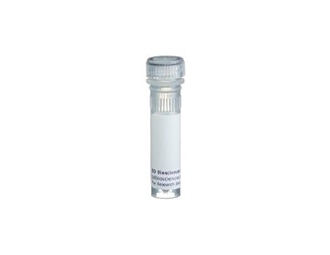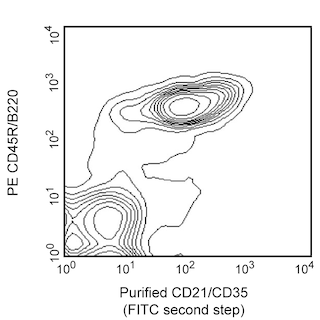Old Browser
Looks like you're visiting us from {countryName}.
Would you like to stay on the current country site or be switched to your country?


Regulatory Status Legend
Any use of products other than the permitted use without the express written authorization of Becton, Dickinson and Company is strictly prohibited.
Preparation And Storage
Product Notices
- Since applications vary, each investigator should titrate the reagent to obtain optimal results.
- Please refer to www.bdbiosciences.com/us/s/resources for technical protocols.
- Caution: Sodium azide yields highly toxic hydrazoic acid under acidic conditions. Dilute azide compounds in running water before discarding to avoid accumulation of potentially explosive deposits in plumbing.
Companion Products


.png?imwidth=320)
The 8C12 antibody recognizes an epitope present on the 190-kDa complement receptor protein, originally designated CR1 (CD35), but not the 145-150-kDa CR2 (CD21) molecule. Unlike the human system, in which these proteins are products of independent genes, both of these mouse receptors are membrane proteins resulting from the alternative splicing of mRNA transcribed from the Cr2 gene. Therefore, an alternative nomenclature has been proposed, designating the proteins Cr2-190 (CD21b) and Cr2-145 (CD21a), respectively. The epitope recognized by 8C12 mAb is only present on CD35/CD21b. Moreover, it has also been proposed that Crry is the true mouse genetic homologue of human CR1 (CD35). In the mouse, CD35 is expressed on the majority of peripheral B cells, on the majority of resident peritoneal macrophages, on peripheral blood granulocytes after treatment with N-formyl-Met-Leu-Phe, and on follicular dendritic cells, but not on thymocytes, T cells, erythrocytes, or platelets. In addition, it has not been detected, at the protein or mRNA level, in the macrophage cell line J774, bone marrow-derived macrophages, or thioglycollate-elicited peritoneal macrophages. The 8C12 mAb has been reported to inhibit rosette formation by C3bbearing sheep erythrocytes, to block the complement-dependent trapping of immune complexes by follicular dendritic cells, and to down-regulate mouse CD35 expression upon in vivo application, inhibiting only some primary antibody responses to immunization. B lymphocytes of Cr2[null] mice display impaired humoral immune responses in vivo. The 8C12 mAb recognizes an epitope on mouse CD35 distinct from the epitope recognized by anti-mouse CD21/CD35 mAb 7G6, and it does not block binding by 7G6 mAb to CD35.
*Please note that the isotype of 8C12 mAb was originally reported to be Rat IgG2c. Further investigations have demonstrated that the isotype of 8C12 mAb is Rat IgG2a.
Development References (12)
-
Ahearn JM, Fischer MB, Croix D, et al. Disruption of the Cr2 locus results in a reduction in B-1a cells and in an impaired B cell response to T-dependent antigen. Immunity. 1996; 4(3):251-262. (Biology). View Reference
-
Fischer MB, Goerg S, Shen L, et al. Dependence of germinal center B cells on expression of CD21/CD35 for survival. Science. 1998; 280(5363):582-585. (Biology). View Reference
-
Fu YX, Huang G, Wang Y, Chaplin DD. B lymphocytes induce the formation of follicular dendritic cell clusters in a lymphotoxin alpha-dependent fashion. J Exp Med. 1998; 187(7):1009-1018. (Clone-specific: Immunohistochemistry). View Reference
-
Heyman B, Wiersma EJ, Kinoshita T. In vivo inhibition of the antibody response by a complement receptor-specific monoclonal antibody. J Exp Med. 1990; 172(2):665-668. (Biology). View Reference
-
Hu H, Martin BK, Weis JJ, Weis JH. Expression of the murine CD21 gene is regulated by promoter and intronic sequences. J Immunol. 1997; 158(10):4758-4768. (Biology). View Reference
-
Kinoshita T, Takeda J, Hong K, Kozono H, Sakai H, Inoue K. Monoclonal antibodies to mouse complement receptor type 1 (CR1). Their use in a distribution study showing that mouse erythrocytes and platelets are CR1-negative. J Immunol. 1988; 140(9):3066-3072. (Immunogen). View Reference
-
Kinoshita T, Thyphronitis G, Tsokos GC, et al. Characterization of murine complement receptor type 2 and its immunological cross-reactivity with type 1 receptor. Int Immunol. 1990; 2(7):651-659. (Biology). View Reference
-
Kurtz CB, O'Toole E, Christensen SM, Weis JH. The murine complement receptor gene family. IV. Alternative splicing of Cr2 gene transcripts predicts two distinct gene products that share homologous domains with both human CR2 and CR1. J Immunol. 1990; 144(9):3581-3591. (Biology). View Reference
-
Martin BK, Weis JH. Murine macrophages lack expression of the Cr2-145 (CR2) and Cr2-190 (CR1) gene products. Eur J Immunol. 1993; 23(11):3037-3042. (Biology). View Reference
-
Molina H, Holers VM, Li B, et al. Markedly impaired humoral immune response in mice deficient in complement receptors 1 and 2. Proc Natl Acad Sci U S A. 1996; 93(8):3357-3361. (Biology). View Reference
-
Wiersma EJ, Kinoshita T, Heyman B. Inhibition of immunological memory and T-independent humoral responses by monoclonal antibodies specific for murine complement receptors. Eur J Immunol. 1991; 21(10):2501-2506. (Biology). View Reference
-
Yoshida K, van den Berg TK, Dijkstra CD. Two functionally different follicular dendritic cells in secondary lymphoid follicles of mouse spleen, as revealed by CR1/2 and FcR gamma II-mediated immune-complex trapping. Immunology. 1993; 80(1):34-39. (Biology). View Reference
Please refer to Support Documents for Quality Certificates
Global - Refer to manufacturer's instructions for use and related User Manuals and Technical data sheets before using this products as described
Comparisons, where applicable, are made against older BD Technology, manual methods or are general performance claims. Comparisons are not made against non-BD technologies, unless otherwise noted.
For Research Use Only. Not for use in diagnostic or therapeutic procedures.
Refer to manufacturer's instructions for use and related User Manuals and Technical Data Sheets before using this product as described.
Comparisons, where applicable, are made against older BD technology, manual methods or are general performance claims. Comparisons are not made against non-BD technologies, unless otherwise noted.
Report a Site Issue
This form is intended to help us improve our website experience. For other support, please visit our Contact Us page.